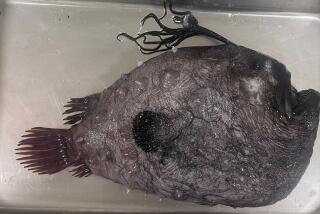Rare Ozark Cavefish Monitors Its World : Environment: Like the fabled canary in a coal mine, presence of the pollution-sensitive fish proclaims the drinking water clean and pure. But it’s getting harder to find.
SPRINGFIELD, Mo. — Years ago, people in the Ozarks were pleased to find a blind, almost colorless fish no longer than a pinky swimming in their drinking water.
The Ozark cavefish is a barometer on the environment, akin to the proverbial canary in a coal mine. Spying the pollution-sensitive fish meant the water it swam in was clean and pure.
“Historically, people called it ‘well keeper’ or ‘spring keeper’ because they’d pump it up or pull it up in buckets from their wells,” said Brian Canaday, a fisheries management specialist with the Missouri Department of Conservation. “The cavefish was kind of a good luck charm.”
Ominously, the Ozark cavefish is much more difficult to find these days. Pollution of ground water supplies has damaged the species to the point that it’s listed as threatened under the federal Endangered Species Act and endangered in Missouri.
The Ozark cavefish is one of six species of cavefish. It’s known to exist only in about two dozen caves in southwestern Missouri, extreme northeastern Oklahoma and far northwestern Arkansas.
“The biggest threat to the Ozark cavefish right now is declining water quality,” Canaday said. “It’s very, very sensitive to subtle changes in ground water quality, which is very important to us because that’s where most of our drinking water comes from.”
Canaday is point man in a conservation department program aimed at helping the Ozark cavefish, and ultimately humans, by increasing public awareness about the fish and its link to ground water quality. He talks with landowners near the caves, explaining how they can help keep ground water clean.
Landowners who don’t know a cavefish from a catfish tend to perk up when they learn of the delicate relationship between the tiny fish and the water they and their families drink, Canaday said.
Pollution creeps into ground water, and eventually into the caves, from a variety of sources, including chemical and pesticide spills, feedlot runoff and leaky septic tanks, Canaday said. Trash often is dumped in sinkholes and abandoned wells in the Ozarks, a practice that also allows contaminants to seep into the water system.
The Ozark cavefish has no eyes. In the pitch-black environment of underground caves, it relies on sensory organs on its head and sides to search out food. It eats whatever limited food enters the cave, from tiny freshwater shrimp to fungus that grows on guano left at the water’s edge by roosting bats, Canaday said.
Last March, 85 scientists and biologists met in Springfield for the second-ever conference held to discuss the Ozark cavefish and its future.
“Basically, scientists in the three states where the Ozark cavefish occurs were all doing work in our own directions and had little knowledge of what others were doing,” Canaday said.
As a child 30 years ago, Bill McNeese of rural Sarcoxie discovered an Ozark cavefish while exploring a cave with his brother. He put it on display at the local drugstore. Folks had never seen one before, he said.
To the delight of McNeese and his family, Ozark cavefish have been found living in a cave on their property. But not all of his fellow landowners are as enthusiastic about the rare fish.
“To most of them, it’s just another instance of the bureaucrats coming in and taking over their property and telling them how to run things,” he said. “But in my opinion, they’d be completely stupid not to be concerned that the water they drink is so bad a cavefish can’t survive in it.”
Canaday emphasizes, in his talks to landowners and school and civic groups, that preventing ground water from becoming polluted is far easier than dealing with the problem once it occurs.
Storing farm chemicals properly and planting trees--or not cutting them down--near cave entrances to keep soil in place and prevent siltation are simple solutions that help ensure water quality and benefit both humans and cavefish.
“I feel very confident that some day the Ozark cavefish will be fully recovered,” Canaday said. “I think the cavefish and landowners can live compatibly. It’s a good luck charm and a good thing to have. People want it there.”
More to Read
Sign up for Essential California
The most important California stories and recommendations in your inbox every morning.
You may occasionally receive promotional content from the Los Angeles Times.










